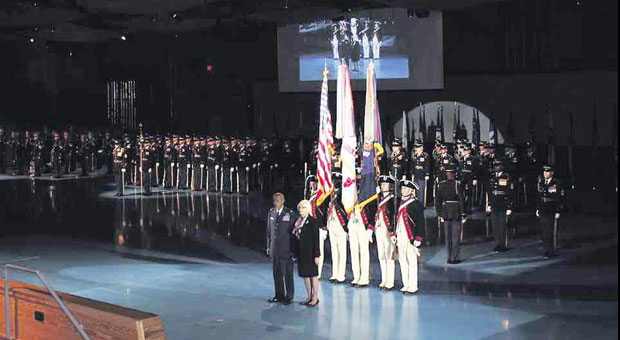Fil-Am vet gets Purple Heart after 70 years

UNSUNG HERO NO MORE Jesse Baltazar, 94, veteran of three wars, receives his overdue medal with a full-dress parade, fixed bayonets, colonial fife and drum corps. CONTRIBUTED PHOTO
LOS ANGELES—Jesse Baltazar survived the horrors of the Bataan Death March in 1942, but it took more than seven decades for the Filipino war veteran to finally receive the US Purple Heart medal.
“I am very thankful. I waited 70 years for this,” Baltazar, a 94-year-old veteran of three wars, said after receiving the presidential award at Joint Base Myer-Henderson Hall in Arlington, Virginia, on Tuesday (Wednesday in Manila).
The Purple Heart is awarded to soldiers wounded or killed while serving in the US military.
Baltazar, who is from Quezon City, told the Inquirer in a phone interview that he had not been given the recognition earlier despite being wounded during World War II because the US Army lost some of his records. He joined the US Armed Forces in the Far East (Usaffe) in 1941.
His family and supporters, including US Secretary of State John Kerry, a Vietnam War veteran like him, lobbied for him to receive the award.
‘Most brutal’
Baltazar, who also served in the Korean War, described the Death March in 1942 as his “most brutal” war experience. “We were forced to march from sunrise to sunset with no food and water,” he said.
What kept him going was his determination not to surrender to the enemy. “I always maintained that I was going to survive and even if I became a prisoner of war, that I would find a way to escape,” he said.
Baltazar, who suffered leg injuries when Japanese planes bombed his camp, used a bamboo stick as a cane when the Japanese military forced him and tens of thousands of Filipino and American soldiers to complete the 104.6-kilometer (65-mile) trek in scorching heat.
Baltazar said he documented his war experiences in his soon-to-be published memoir, titled “The Naked Soldier.”
No uniforms, guns
“The title is ‘The Naked Soldier’ because when we were inducted (into) the military, there were no uniforms and no weapons,” Baltazar said, who joined the Usaffe after the Japanese bombed Pearl Harbor and prepared to invade the Philippines.
After the war, he moved to the United States and pursued his military career, becoming the first native-born Filipino to join the US Air Force in 1948.
After he retired with the rank of major, Baltazar joined the US Department of State and served as a deputy provincial adviser in Vietnam from 1966 to 1970.
“This award is 70 years overdue,” Army Chief of Staff Gen. Ray Odierno said at the award ceremony, Stars and Stripes reported.
“It’s important for all of us who have worn the uniform of the United States Army [to] ensure that those who have earned awards through their service be recognized, especially those who have served with distinction and sacrificed selflessly for this great nation of ours,” Odierno added.
Bing Branigin, a Filipino-American community leader who attended the event, said Baltazar’s award “represents the heroism and dignity of all Filipino WWII veterans.”
Elaborate ceremony
Also present was retired Maj. Gen. Antonio Taguba, who described the event as “replete with full-dress parade with soldiers from the 3rd Infantry Regiment, the old guard in formal uniform and fixed bayonets on their rifles, members of the colonial army, and colonial fife and drum corps.”
Taguba said the elaborate ceremony was a fitting recognition of Baltazar’s “outstanding achievements of service to the nation.”
“He clearly represented his fellow Fil-Am veterans … and is testament to why our country must recognize these brave and honorable men and women with the Congressional Gold Medal,” said Taguba, who is leading a nationwide campaign to push the US government to award the medal to Filipino war veterans.
“The Japanese were given medals, but not those with the Philippine Army,” Baltazar said in Filipino, referring to the Japanese American Nisei soldiers, who have been recognized with a Congressional Gold Medal, the highest civilian award given by the US Congress.
Other war veterans, including the Navajo Code Talkers, Montford Marines, Tuskegee Airmen and Women Air Service Pilots, were also awarded the medal.
No recognition
The Filipino veterans and their supporters contend that there has never been a formal declaration recognizing the Filipino soldiers for their sacrifice and loyal service during the war.
About 260,000 Filipinos fought for the United States during the war and they were promised equal treatment as American veterans after the war.
But in 1946, US Congress enacted the Rescission Act, which took away full recognition of the Filipinos and stripped them of their benefits, leaving bitterness in the former colony and decades of campaigning to change US policy.
In 2009, Congress approved a stimulus package that included one-time payments of $15,000 to Filipino veterans in the United States and $9,000 to those living in the Philippines.
However, community advocates said thousands of veterans had their claims denied, usually because US authorities did not accept records from the Philippines, which were the former fighters’ sole means to prove their service.
For love of farming
Baltazar said he grew up on Kanlaon Street in Quezon City. He attended the University of the Philippines’ Rural High School in Los Baños town, Laguna province, because he “wanted to become an agriculturist.”
He later decided to become a doctor instead so he pursued a premedicine course in college. He continued his studies at Georgetown University, where he earned his bachelor’s degree, and later obtained his master’s in education at the University of Virginia.
Baltazar said he went back to his first love—agriculture—after retirement. He has been spending his time tending grapevines, and apple and pear orchards on his 12-hectare (30-acre) farm in Virginia.
RELATED STORIES
Bipartisan US effort to help Filipino WWII veterans lauded
US House continues inquiry into Filipino WWII veterans’ claims
Congressional Medal campaign for Filipino World War II vets gains support


















